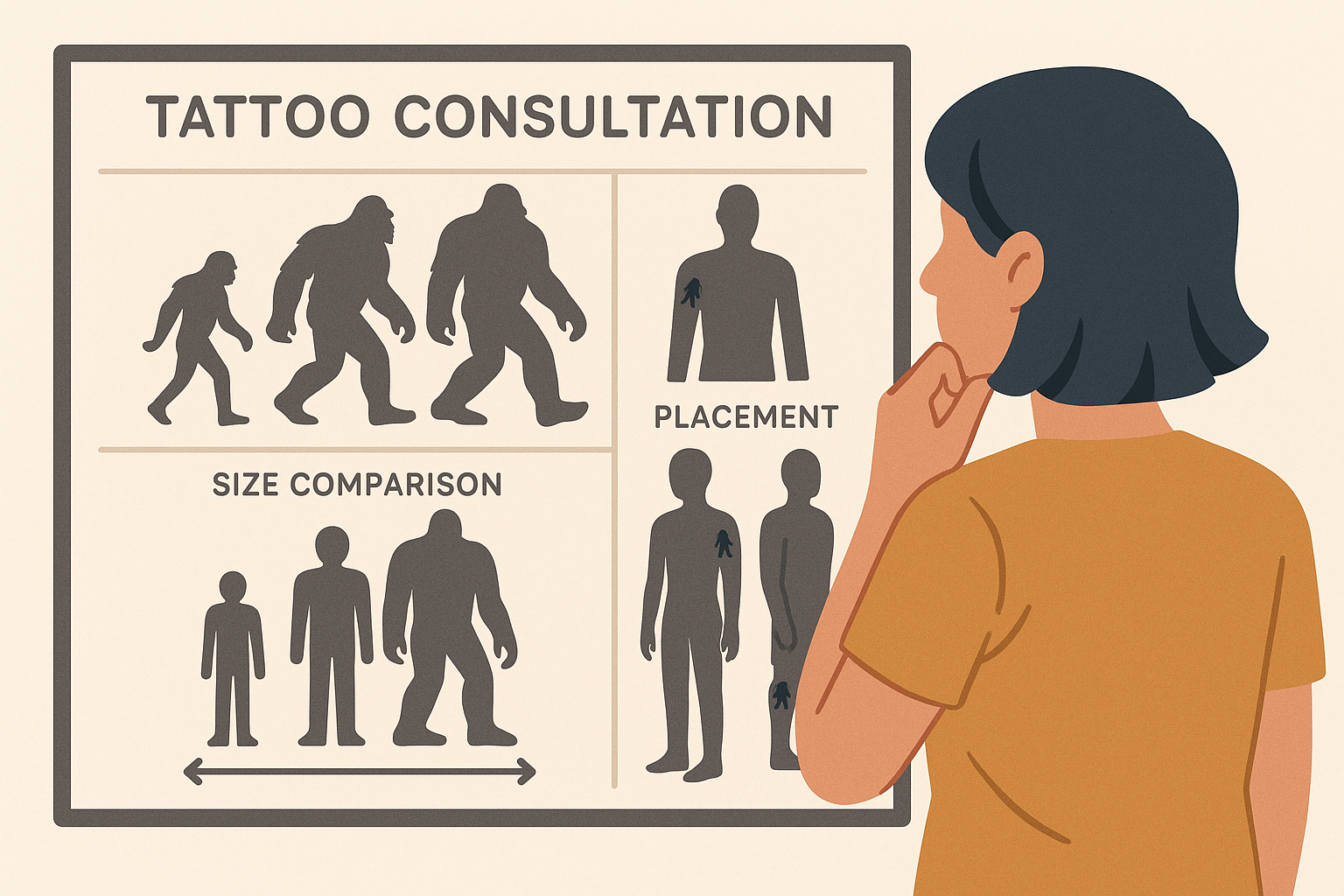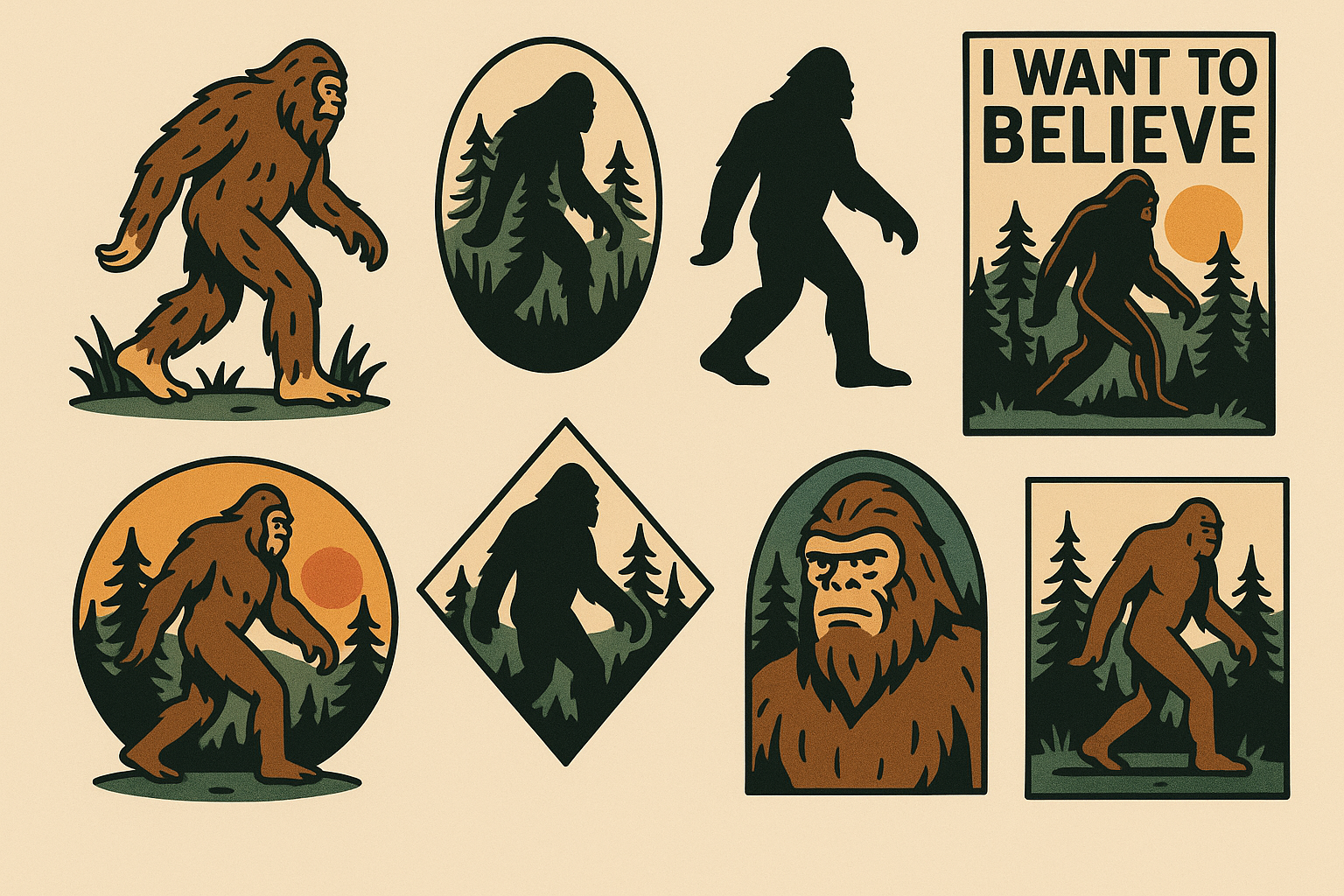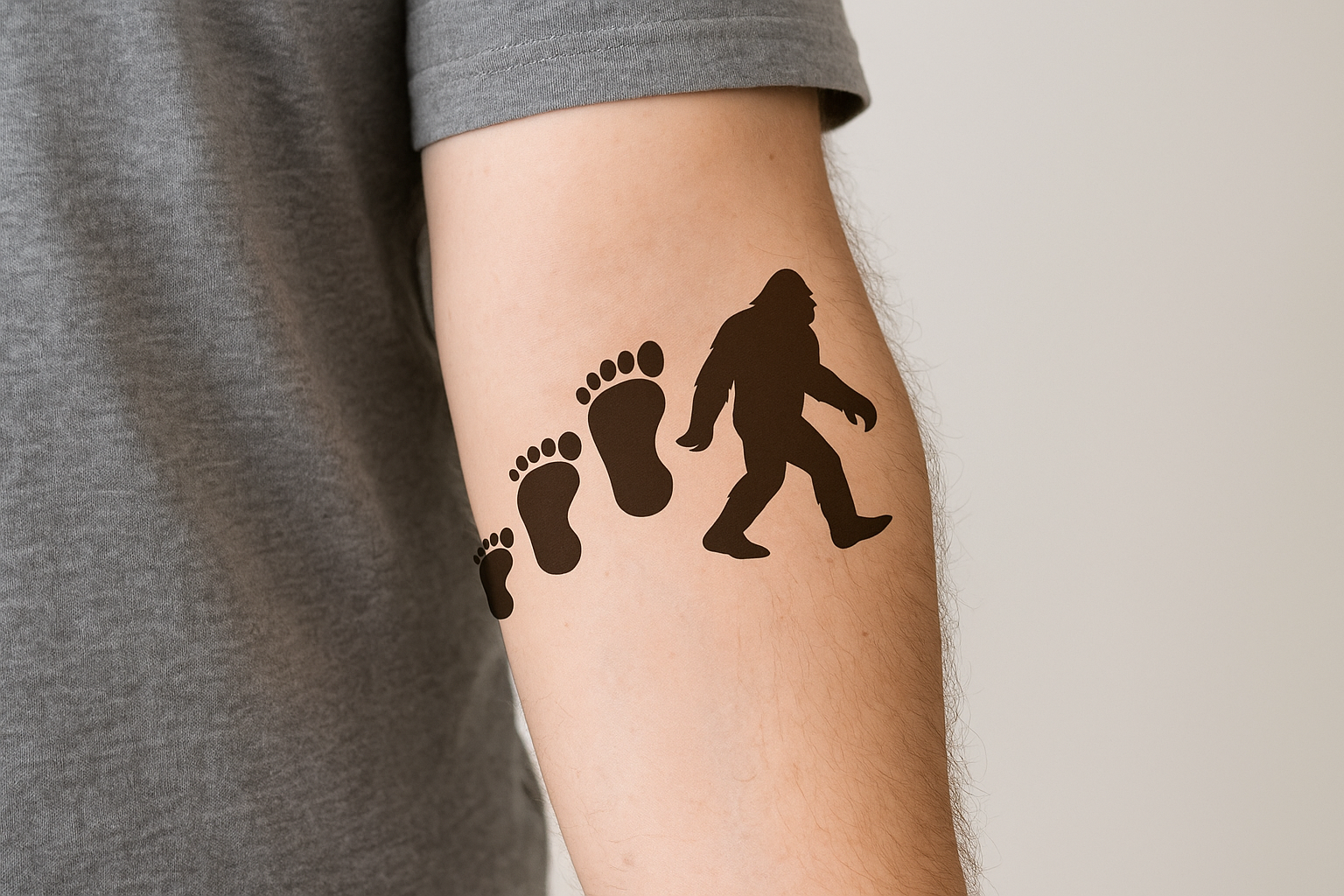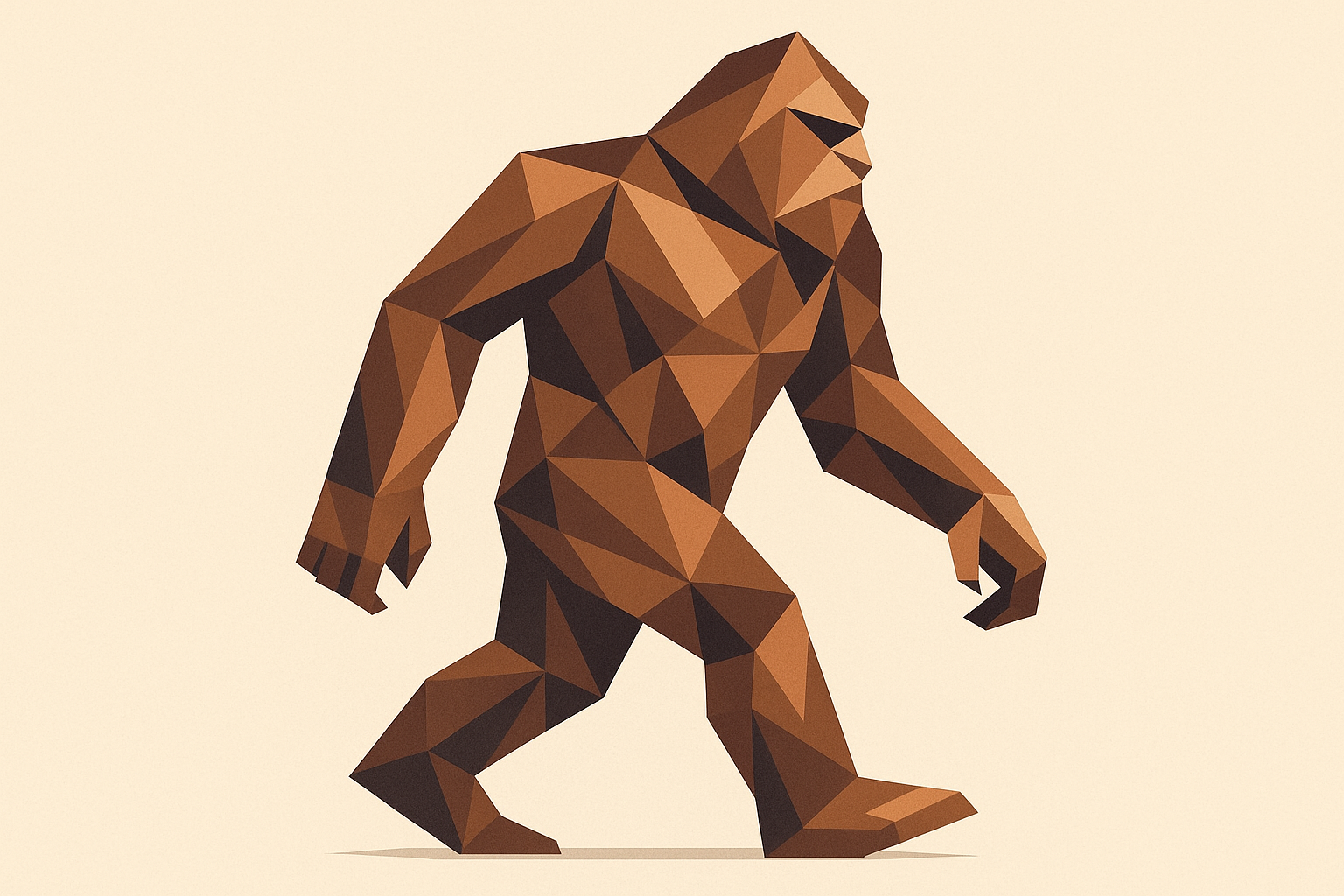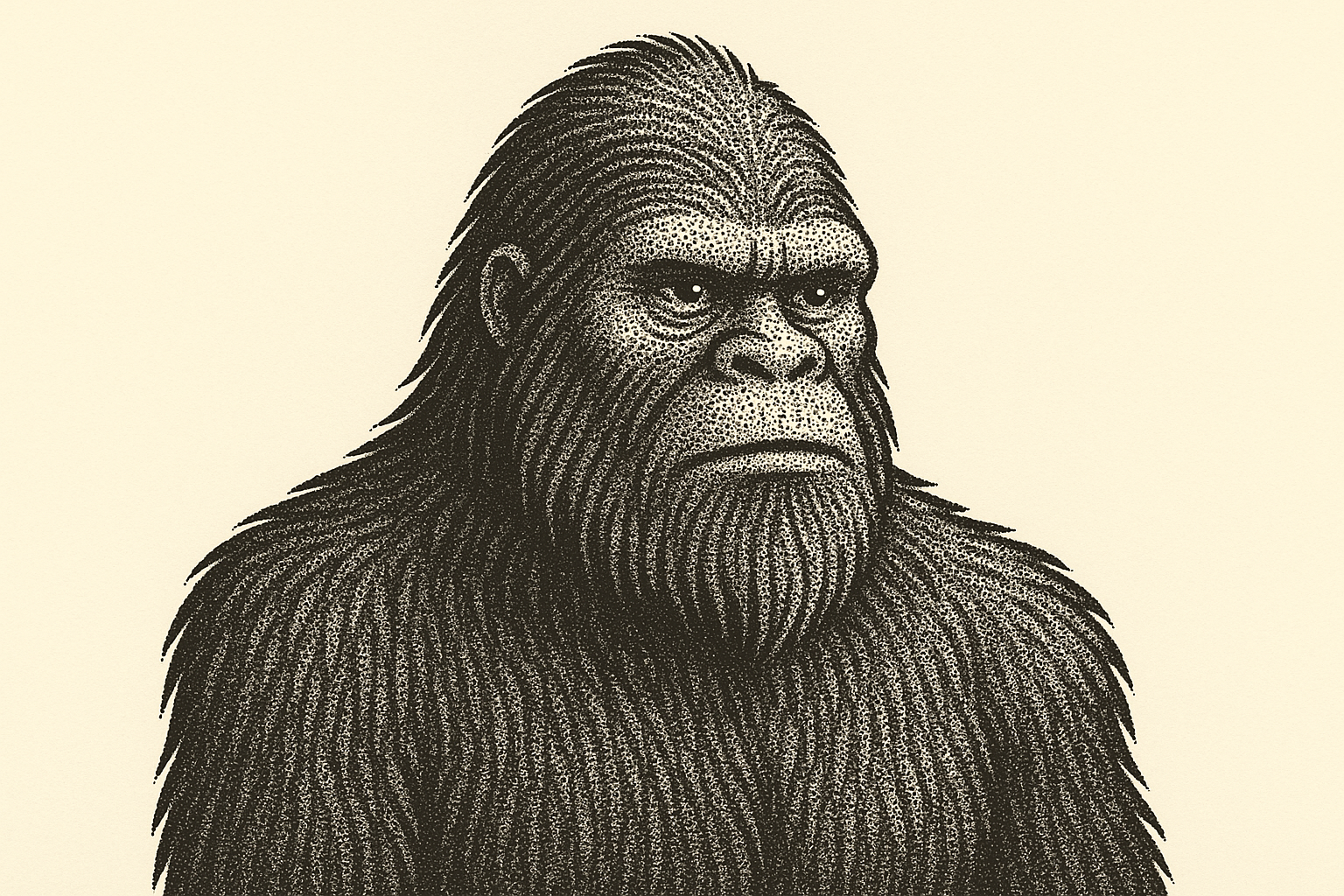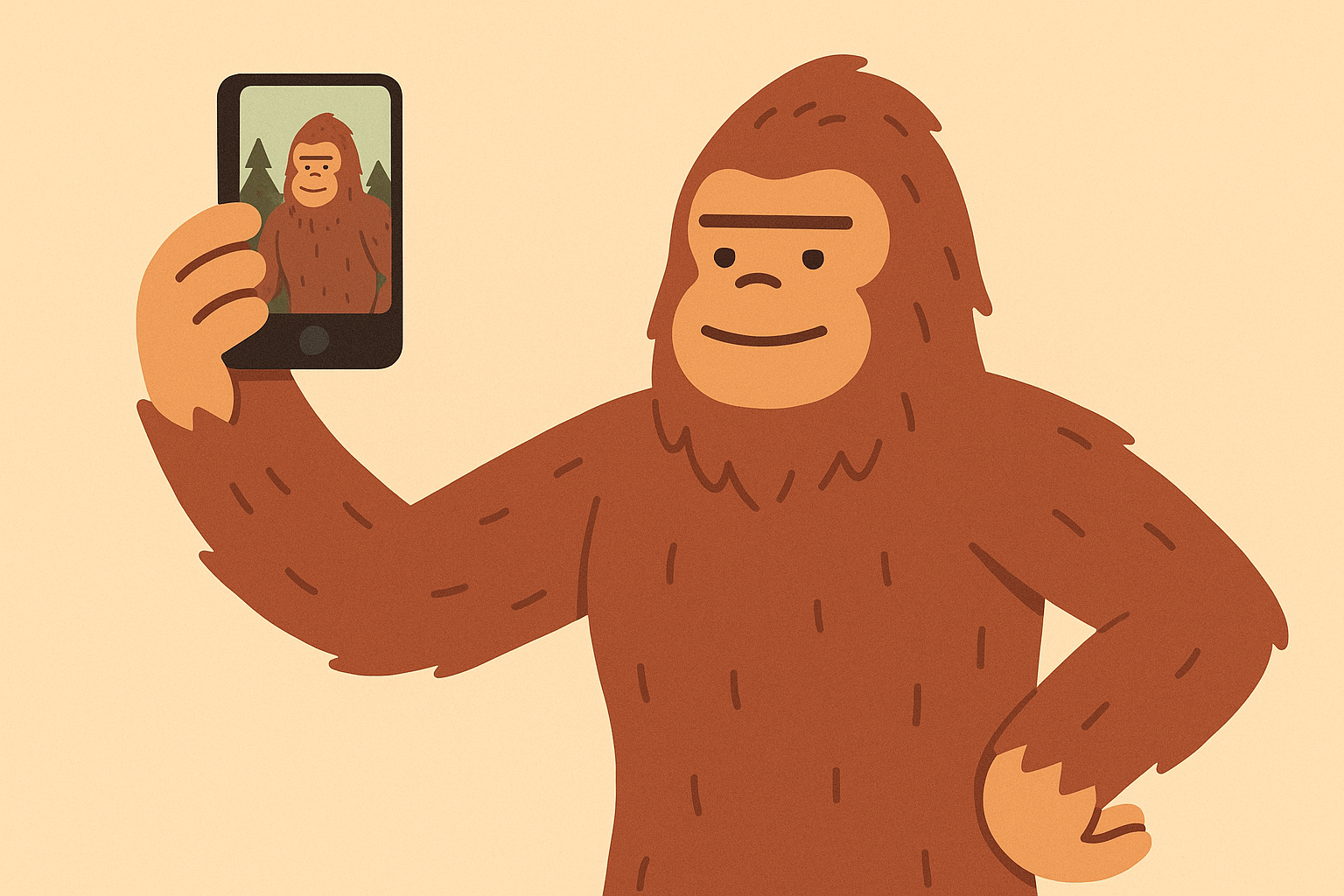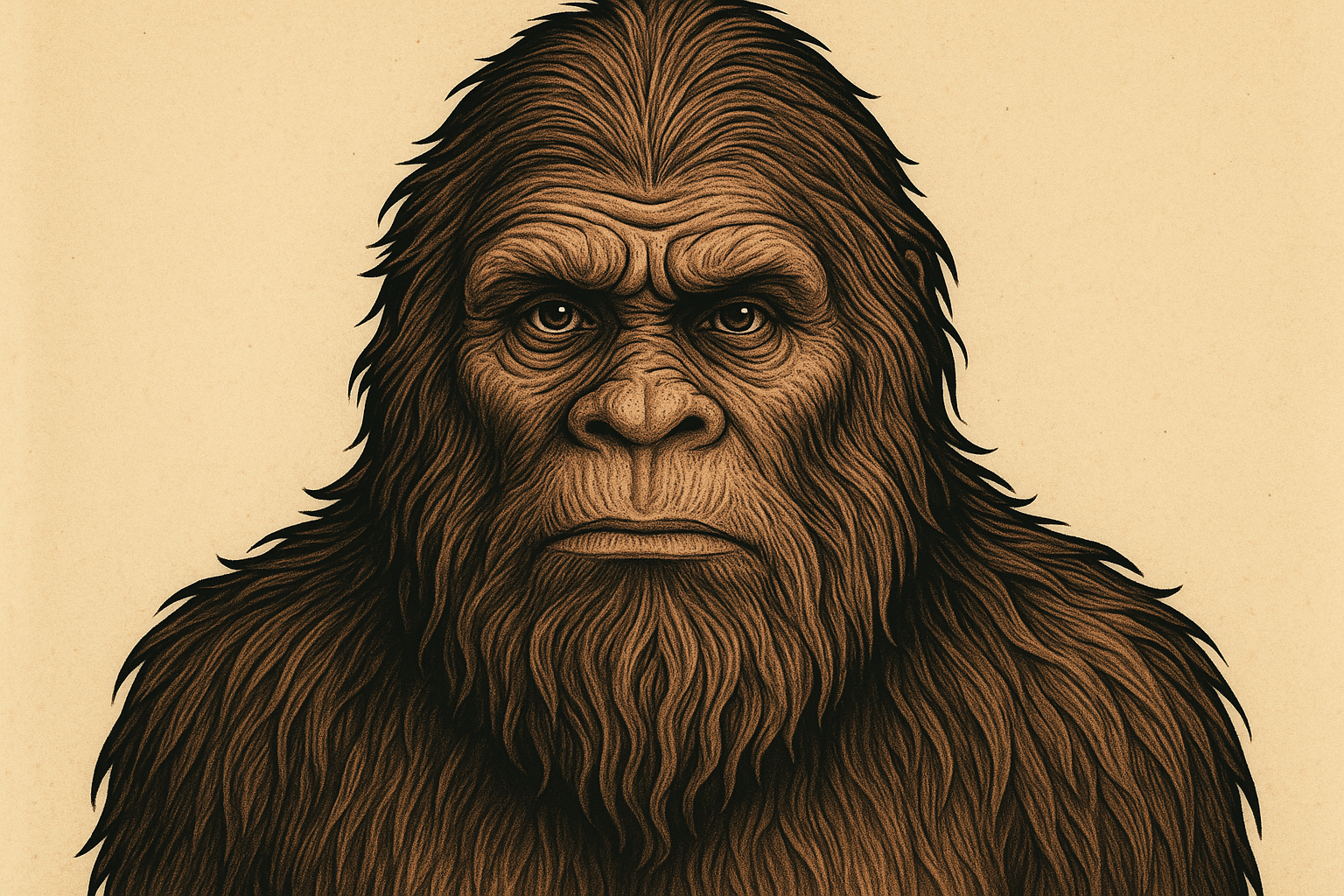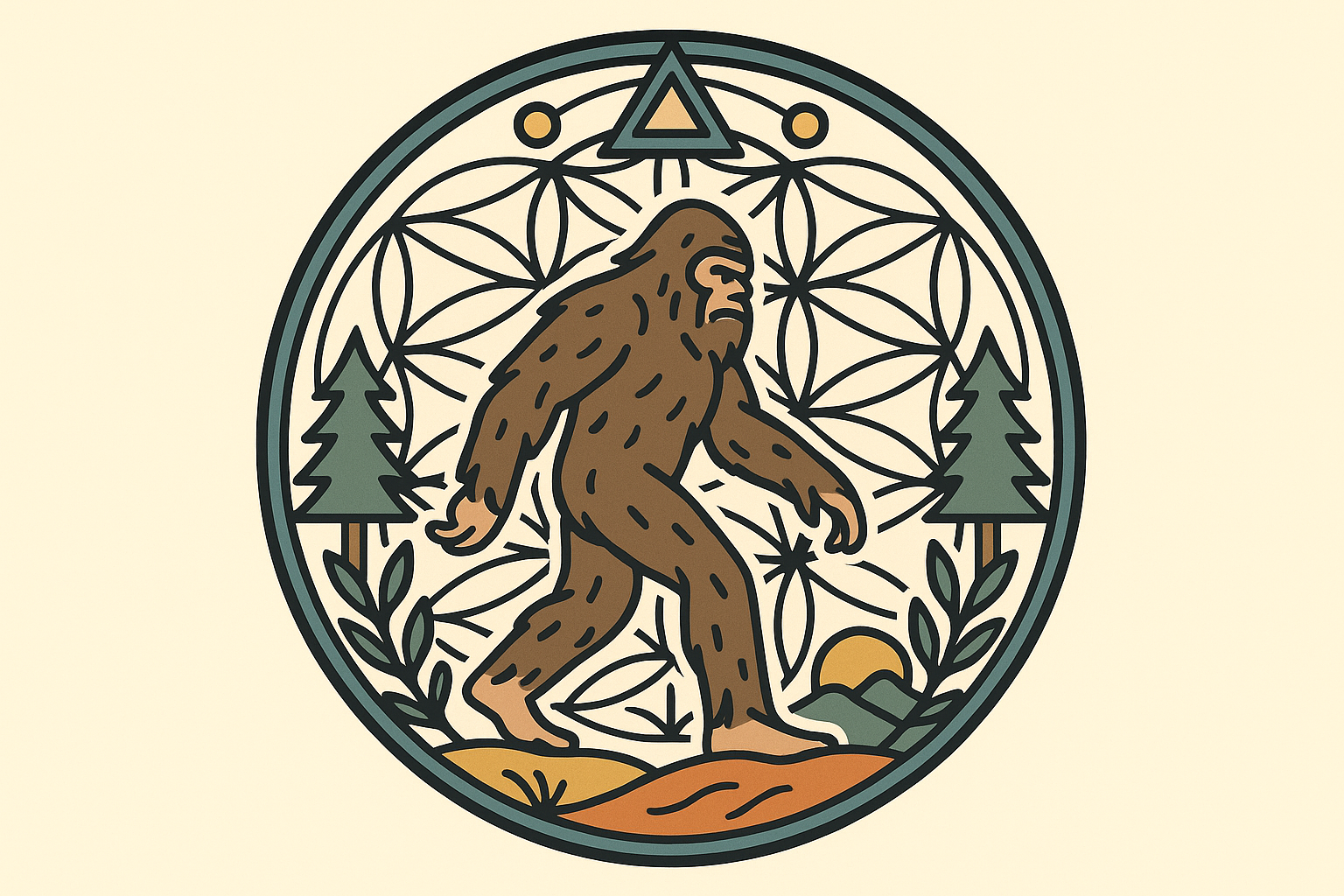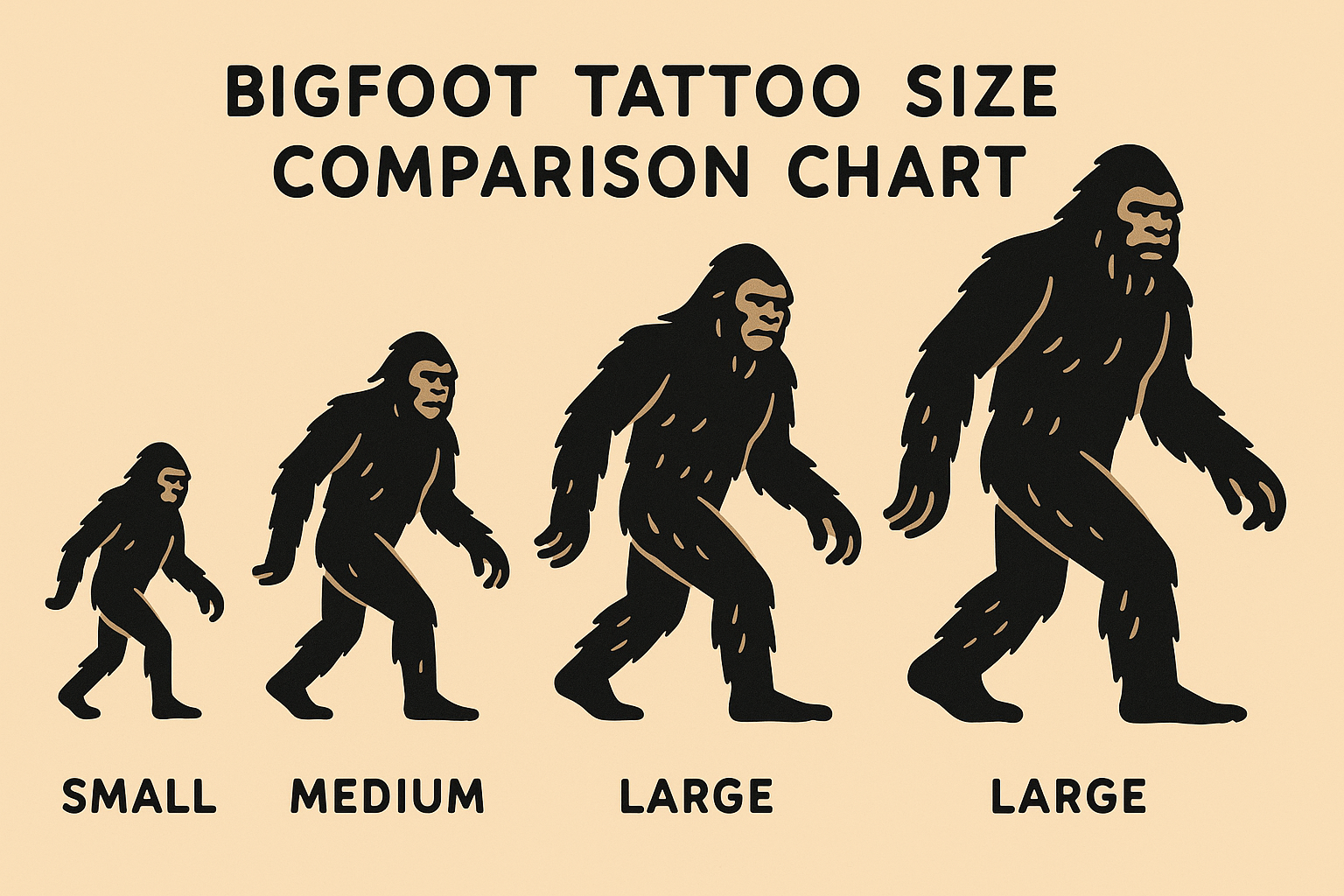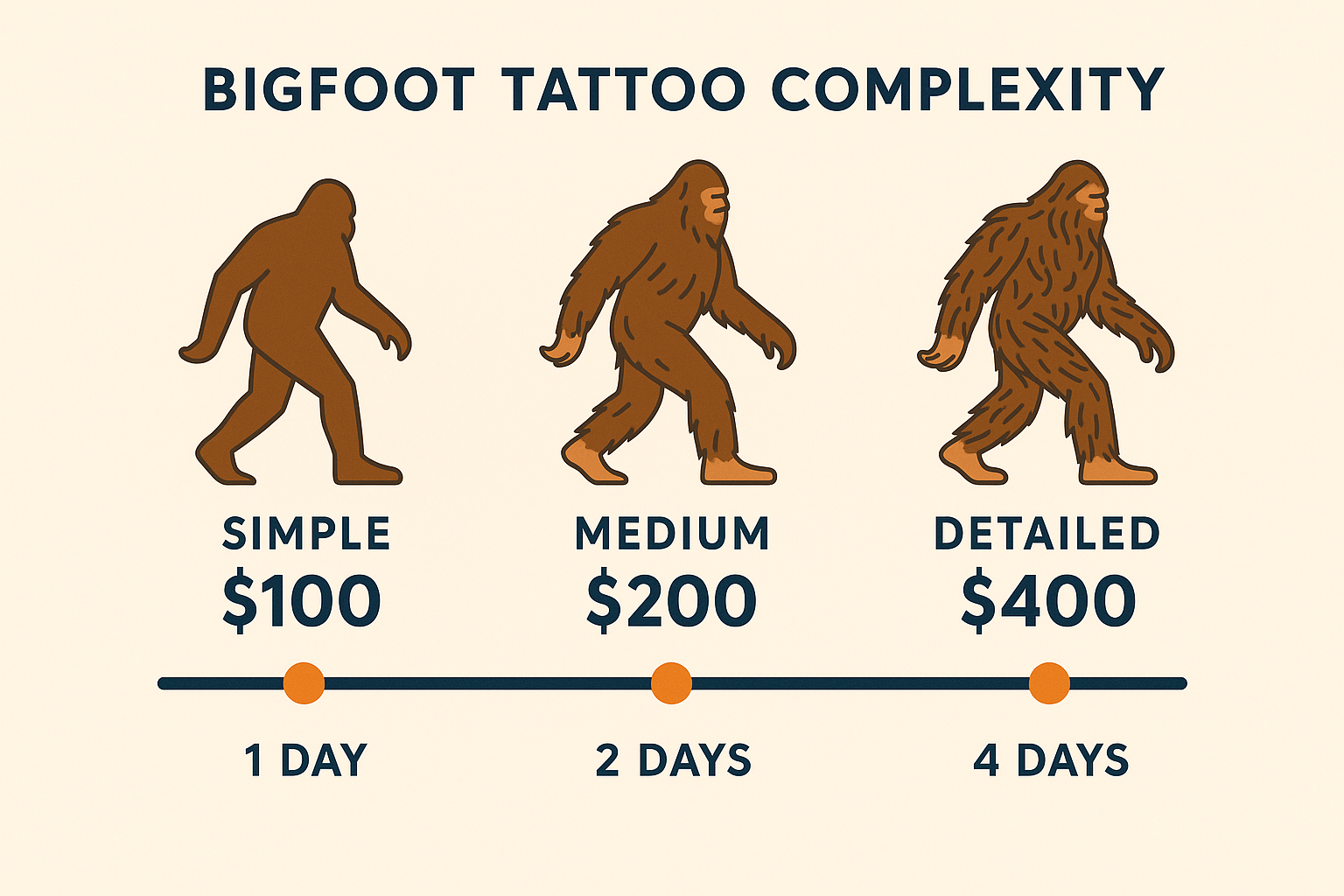25 Epic Bigfoot Tattoo Designs That’ll Make You a Legend (Complete Guide)
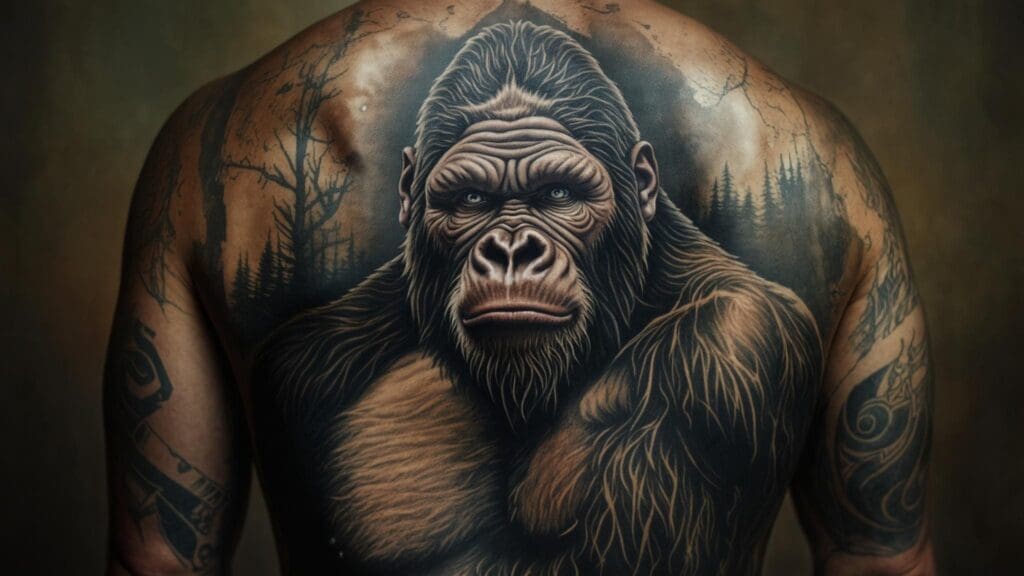
I’ve spent years diving deep into the world of cryptozoology tattoos, and let me tell you – bigfoot tattoos have absolutely exploded in popularity. Whether you’re a hardcore believer in Sasquatch or just love the mystery and folklore, these designs offer incredible storytelling potential on your skin.
This guide breaks down 25 unique bigfoot tattoo designs that I’ve personally worked on or seen done right. I’ll walk you through everything from classic silhouettes to modern artistic interpretations, helping you understand what actually works, what doesn’t, and what you need to know before sitting in that chair. By the end, you’ll know exactly which design matches your style and budget.
Table of Contents
- Essential Stuff You Need to Know Before Getting Inked
- Traditional & Classic Bigfoot Tattoo Designs (8 Designs)
- Modern & Artistic Bigfoot Interpretations (6 Designs)
- Humorous & Pop Culture Bigfoot Tattoos (5 Designs)
- Realistic & Detailed Bigfoot Tattoos (4 Designs)
- Unique & Creative Bigfoot Concepts (2 Designs)
- What Actually Works in Real Life
- Size and Placement Reality Check
- Cultural Stuff You Should Know
- What It’ll Actually Cost You
- Final Real Talk
TL;DR
- Small bigfoot tattoos work best with simple line art and classic silhouettes – anything more detailed turns into a blob
- Traditional forest scenes need bigger spaces but they’re worth it for the storytelling impact
- Geometric and watercolor styles are trendy now but require artists who actually know what they’re doing
- Funny designs like selfie-taking bigfoot are conversation starters and age well
- Photorealistic portraits cost serious money but look incredible when done right
- Budget-friendly options start around $150, while premium pieces can hit $2000+
- If you’re going with Pacific Northwest traditional styles, do your research on cultural respect
Essential Stuff You Need to Know Before Getting Inked
Before you commit to any bigfoot tattoo design, we need to talk about the stuff that’ll make or break your satisfaction with the final result. I’ve seen too many people rush into complex designs without thinking about how they’ll actually work on their body or fit their budget.
Size and placement decisions are huge. Larger designs let you get intricate details like facial features and fur texture, while smaller pieces work better as clean silhouettes. Your body’s natural shape matters too – bigfoot’s imposing figure flows beautifully across a back or chest, but smaller versions work great on arms or shoulders.
Style compatibility is about making sure your tattoo actually reflects who you are. Traditional approaches use bold lines and limited colors, creating iconic bigfoot silhouettes that’ll still look good when you’re 70. Realistic techniques capture that mysterious, almost human quality that makes bigfoot so compelling.
Geometric styles turn the creature into striking angular art, while watercolor methods add that mystical, supernatural vibe that emphasizes the legend’s otherworldly aspects.
Cultural significance varies big time depending on your approach. Pacific Northwest indigenous traditions view the creature through spiritual lenses that deserve serious respect. Modern cryptozoology focuses on the scientific mystery. Pop culture stuff embraces humor and internet memes. Figure out what bigfoot means to you personally before picking your design.
When you’re thinking about placement, understanding tattoo pain levels across different body areas can help you make smart decisions about size and location.
| Factor | Small (1-4 inches) | Medium (4-8 inches) | Large (8+ inches) |
|---|---|---|---|
| Detail Level | Keep it simple | Some texture okay | Go nuts with details |
| Best Spots | Wrist, ankle | Forearm, calf | Back, chest, thigh |
| Time Needed | 1-3 hours | 3-6 hours | 8-20+ hours |
| Cost Range | $100-400 | $400-800 | $800-2500+ |
| Best Styles | Silhouettes, line art | Geometric, traditional | Realistic, detailed scenes |
Technical stuff often determines which artists can actually pull off your chosen design. Bigfoot tattoos frequently involve tricky elements like fur texture, detailed backgrounds, and dramatic lighting. Some designs need artists with specific skills in portraits, wildlife, or intricate linework. Think about how your tattoo will age – fine details might blur over time, but bold silhouettes stay sharp for decades.
Budget and time vary wildly between simple and complex bigfoot designs. Basic outlines can be done in one session without breaking the bank, while elaborate forest scenes might need several appointments and serious cash. Complex realistic portraits often cost premium prices because of the specialized skills and time involved.
For detailed pricing info, check out our guide on how much tattoos cost to understand what you’re looking at financially.
Traditional & Classic Bigfoot Tattoo Designs (8 Designs)
Look, if you’re going for a traditional bigfoot tattoo, you can’t go wrong with these classics. I’ve been tattooing cryptid designs for over a decade, and these eight styles never go out of fashion. They’re like the little black dress of the bigfoot world – always appropriate, always recognizable.
1. Classic Bigfoot Silhouette
This is your bread and butter bigfoot design. Just a solid black silhouette showing that iconic hunched-over walk we all know from grainy footage. It’s perfect if you want something that screams “bigfoot” without breaking the bank or your pain tolerance.
I love this design because it works anywhere on your body. Want it tiny on your ankle? Done. Want it huge across your back? Also works. A client of mine got a 3-inch version on his forearm, and people spot it from across the room. Sometimes simple really is better.
The trick is getting those proportions right – the long arms, that distinctive slouch, the powerful stride. Mess that up and you’ve got a generic ape-man instead of our beloved Sasquatch.
2. Bigfoot Forest Scene
Now we’re talking! This is where traditional American tattooing really shines. Picture bigfoot emerging from some gnarly pine trees with those thick, bold outlines that’ll still look crisp when you’re 80.
I did one of these on a guy’s entire back last year. Took us three sessions – first for the outline, then the forest details, and finally the color work. We used classic greens for the pines and this gorgeous sunset orange peeking through the trees. Cost him about $1,200, but man, it was worth every penny.
Real-World Example: Mike, a hiking enthusiast, wanted a 10-inch bigfoot forest scene on his back. We designed bigfoot emerging from Pacific Northwest pine trees with traditional American styling – bold black outlines with strategic green in the pine needles and red sunset highlights. Three 4-hour sessions: outline first, then forest details, then color work and finishing touches. Total investment: $1,200, and it still looks incredible two years later.
Fair warning though – you need real estate for this one. Don’t try cramming a forest scene into a 4-inch space. Trust me, I’ve seen the disasters.
3. Vintage Cryptozoology Poster Style
Remember those cheesy 70s “SASQUATCH SPOTTED” posters? This design captures that whole vibe perfectly. We’re talking weathered text, sepia tones, maybe some fake “scientific” measurements thrown in for good measure.
One of my favorite versions included “MISSING LINK FOUND” in that classic 70s font with distressed edges like it had been hanging in some small-town diner for decades. The nostalgia factor is off the charts, and it’s a great conversation starter.
The documentary-style approach often includes measurement markers, location references, or scientific notes that add credibility to the mysterious subject. Those sepia tones and aged paper textures create that authentic vintage research feel.
4. Pacific Northwest Traditional
Okay, this one requires some cultural sensitivity, folks. We’re talking about incorporating indigenous Pacific Northwest art styles – the flowing lines, geometric patterns, that distinctive tribal aesthetic. But here’s the thing: if you’re not connected to that culture, you need to approach this respectfully.
Understanding tribal tattoo meanings becomes crucial when you’re incorporating indigenous artistic elements, ensuring you’re honoring rather than appropriating cultural heritage.
I always recommend clients research the cultural significance first and maybe even connect with indigenous artists in their area. When done right, these designs are absolutely stunning – all those traditional reds and blacks creating this powerful, spiritual representation of Sasquatch.
The flowing lines create movement and spiritual energy while geometric elements add balance. This approach demands cultural sensitivity and understanding to ensure respectful execution.
5. Bigfoot Footprint Trail
This design tells a story, and I’m a sucker for narrative tattoos. You start with small prints and gradually work up to larger ones, ending with the full bigfoot reveal. It’s like breadcrumbs leading to the main event.
I’ve done this as a wraparound on arms and legs, and it works beautifully. The footprints can follow your body’s natural curves, and you can add little details like mud textures or forest debris around each print. One client even had me add tiny stick figures running away from the larger prints – hilarious and perfectly executed.
The trail can include environmental elements like mud textures, forest debris, or terrain changes that add realism. This design’s linear nature makes it perfect for arms or legs where the story can unfold naturally.
6. Classic Encounter Scene
The Patterson-Gimlin film – if you know, you know. That iconic shot of bigfoot looking back over his shoulder is probably the most famous cryptid image ever captured. It’s dramatic, it’s mysterious, and it makes for an incredible tattoo.
The key is getting that body language right. That casual-yet-alert look back, the powerful stride, the sense that this creature could disappear into the forest at any moment. It’s all about capturing that split second of contact between our world and theirs.
Medium to large placement ensures those facial details and body language stay clear and impactful. That over-the-shoulder pose creates perfect dramatic tension.
7. Bigfoot Family Portrait
Here’s where we get into the “gentle giant” interpretation of bigfoot. Instead of a scary monster, you’ve got a family – maybe a big papa bigfoot with some smaller ones, showing that these creatures have relationships and social structures.
I had a client get this after his daughter was born. The big bigfoot was protecting two smaller ones, and for him, it represented his role as a father and protector. These designs hit different when they have personal meaning behind them.
The composition requires careful balance to show relationships without creating visual chaos. Size variations indicate age differences while positioning suggests family dynamics and protective behaviors.
8. Vintage Camping Warning Sign
This one’s just fun. Picture an old, weathered national park sign warning campers about sasquatch sightings. Maybe throw in some bullet holes or claw marks for authenticity. It’s got that perfect blend of humor and “what if this is real?” energy.
The weathering effects are crucial here. You want it to look like it’s been hanging on a tree for decades, sun-bleached and beat up by the elements. When done right, people do double-takes wondering if it’s a real sign they just never noticed before.
Official park signage aesthetics create humor while maintaining authenticity. Text like “BEWARE” or “SASQUATCH CROSSING” combined with distressed metal textures and faded colors evoke genuine park service materials.
Modern & Artistic Bigfoot Interpretations (6 Designs)
Now we’re getting into the fun stuff. These modern interpretations take traditional bigfoot imagery and give it a contemporary twist. If you’re looking for something that stands out from the typical cryptid crowd, these are your designs.
9. Geometric Bigfoot
Think low-poly video game meets cryptozoology. We’re breaking bigfoot down into angular, geometric shapes – triangles and polygons that somehow still clearly read as our favorite forest friend.
This style is huge right now, especially with younger clients. The clean lines and mathematical precision appeal to people who want something modern and artistic. I usually add some subtle gradient work or metallic accents to really make it pop.
The challenge is maintaining those recognizable bigfoot proportions while working within geometric constraints. Too abstract and people won’t know what they’re looking at. Too literal and you lose the geometric aesthetic.
Triangle and polygon shapes build the figure while maintaining proper proportions. Medium-sized placements work best – you need space for geometric complexity without overwhelming smaller areas.
10. Watercolor Bigfoot
Watercolor tattoos are tricky, but when they work, they’re absolutely magical. Picture bigfoot emerging from misty forest colors that bleed and blend into each other – forest greens flowing into earth browns, with maybe some ethereal blues suggesting morning mist.
Here’s the reality check though: watercolor tattoos require touch-ups. Those soft colors will fade, and you’ll need to refresh them every few years to maintain that dreamy, artistic look. Not everyone wants that maintenance commitment.
I always tell clients to find an artist who really specializes in watercolor techniques. This isn’t the style to experiment with – you need someone who understands color theory and has a portfolio full of successful watercolor pieces.
Forest greens, earth tones, and misty blues create atmospheric effects. Color bleeding and gradient transitions add movement while maintaining that organic wildlife feel.
11. Minimalist Line Art
Sometimes less really is more. These single-line bigfoot drawings capture everything essential about the creature in one continuous stroke. No shading, no color, just pure, clean linework.
Perfect for first tattoos or small placements. I’ve done 2-inch versions on wrists that pack just as much punch as massive back pieces. The trick is knowing exactly which details are essential and which you can eliminate without losing the subject.
Client Success Story: Sarah, one of my regular clients, got a minimalist single-line bigfoot on her wrist for $150. Just 2 inches tall, but that continuous line captured the creature’s hunched posture and powerful stride perfectly. Took 45 minutes, and two years later it still looks as sharp as day one. Sometimes the simplest approach creates the most lasting impact.
The continuous line creates visual flow and artistic elegance while keeping costs minimal. Success depends on understanding which details are essential for recognition and which can be eliminated.
12. Abstract Forest Guardian
This approach blends bigfoot seamlessly into abstract forest landscapes. The creature becomes part of the environment – maybe emerging from tree bark or dissolving into mountain silhouettes. It’s all about that connection between bigfoot and nature.
The flowing, organic shapes work beautifully with the body’s natural curves. I love doing these on shoulders and backs where the design can follow the muscle structure naturally. It’s like the tattoo becomes part of your body’s landscape.
Flowing organic shapes and earth-tone colors create visual unity between creature and surroundings. The design might show bigfoot emerging from or dissolving into the forest, emphasizing the creature’s legendary ability to remain hidden.
13. Dotwork Bigfoot Portrait
Stippling and dotwork create incredible texture and depth, but fair warning – these take forever. We’re talking 15+ hours of meticulous dot placement to build up shadows and highlights. It’s meditation-level tattooing.
The results are worth it though. I’ve done dotwork bigfoot portraits that look like museum-quality illustrations. The technique photographs beautifully and ages really well since it’s all linework, no color to fade.
Just be prepared for the time and cost commitment. These aren’t weekend warrior tattoos – they’re serious artistic investments.
Dot density, spacing, and pattern variations create tonal values and textural effects. Completion typically requires 15+ hours across multiple sessions, but results justify the investment through exceptional artistic quality.
14. Neo-Traditional Bigfoot
This is traditional tattooing’s cooler, more sophisticated cousin. We keep those bold outlines that define traditional work but add enhanced colors, better shading, and more realistic proportions.
It’s perfect for clients who love the classic tattoo aesthetic but want something with more depth and dimension. You get the timeless appeal of traditional work with modern technical improvements.
Enhanced color options allow for sophisticated environmental backgrounds and dramatic lighting effects that weren’t possible in classic traditional tattooing. Improved shading techniques add dimension while bold outlines ensure the design ages well.
Humorous & Pop Culture Bigfoot Tattoos (5 Designs)
Let’s have some fun! These designs prove that cryptozoology doesn’t have to be serious all the time. Some of my favorite tattoos are the ones that make people smile.
15. Bigfoot Taking a Selfie
The ultimate irony – the world’s most camera-shy creature documenting himself on Instagram. I’ve done versions with hashtags like #BigfootSelfie and #CryptidLife. It never gets old watching people’s reactions to this one.
The composition usually shows bigfoot holding a phone at that classic selfie angle, maybe with some forest background visible on the phone screen. Sometimes I’ll add notifications or app icons for extra contemporary flavor.
Social media elements like hashtags or app interfaces enhance the contemporary feel. This design appeals strongly to younger demographics who appreciate the irony of the world’s most elusive creature becoming a social media influencer.
16. Bigfoot Alien Encounter
Two mysteries for the price of one! Whether it’s bigfoot getting abducted by aliens or just having a friendly chat with some grays, this design appeals to anyone who loves unexplained phenomena.
The sci-fi elements give me great opportunities for dramatic lighting – those classic UFO beams, glowing alien eyes, metallic spacecraft details. It’s like combining two conspiracy theories into one awesome tattoo.
UFO elements add color opportunities through glowing lights and energy beams. The dual-mystery theme creates rich storytelling while appealing to broader audiences interested in multiple unexplained phenomena.
17. Hipster Bigfoot
Pacific Northwest meets Portland coffee culture. Picture bigfoot in flannel and glasses, maybe holding a craft beer or artisanal coffee. It’s perfect regional humor that works especially well if you’re actually from the PNW.
I’ve added text like “Locally Sourced Sasquatch” or “Artisanal Forest Dweller” for clients who really want to lean into the joke. The key is making sure the hipster accessories enhance bigfoot’s natural features rather than hiding them.
Text elements enhance the cultural commentary while adding typographic interest. Success depends on selecting accessories that complement rather than obscure bigfoot’s recognizable characteristics.
18. Bigfoot Hide and Seek Champion
This one celebrates bigfoot’s legendary elusiveness. Maybe he’s peeking out from behind a tree with a trophy or championship ribbon. It’s family-friendly humor that works for all ages.
The joke plays perfectly on bigfoot’s most famous trait – nobody can find this guy! I’ve done versions with scorecards showing bigfoot’s undefeated record or “World Champion” banners draped between trees.
Championship elements like ribbons, trophies, or scorecards add visual interest while reinforcing the playful premise. This family-friendly approach appeals to parents and anyone who appreciates gentle humor.
19. Bigfoot Crossing Guard
Putting cryptids in everyday jobs never stops being funny. Bigfoot as a barista, yoga instructor, or crossing guard – it’s all about that contrast between legendary mystery and mundane employment.
One client got bigfoot in a safety vest holding a stop sign. The humor comes from imagining how this massive, legendary creature would handle routine work responsibilities. It’s approachable and conversation-starting without being disrespectful to the legend.
Professional accessories should enhance rather than hide the creature’s distinctive features. The contrast between legendary status and ordinary job responsibilities creates approachable, family-friendly interpretations.
Realistic & Detailed Bigfoot Tattoos (4 Designs)
Now we’re in serious territory. These designs require top-tier artists and significant investment, but the results are absolutely stunning.
20. Photorealistic Bigfoot Portrait
This is the holy grail of bigfoot tattoos – museum-quality realism that looks like wildlife photography on skin. We’re talking individual fur strands, expressive eyes, and dimensional shading that makes the creature seem alive.
I won’t lie – these are expensive. You’re looking at $1500-3000 and 20+ hours of work. But when you find the right artist, the results are jaw-dropping. I’ve seen photorealistic bigfoot portraits that stop people in their tracks.
Make sure your artist has a solid portfolio of realistic animal work before committing. This isn’t the style to gamble on.
Large placements on back or chest provide adequate canvas for required detail. The investment reflects specialized skills needed, but results justify the commitment through exceptional artistic value.
21. Bigfoot in Natural Habitat
Full ecosystem tattoos featuring bigfoot in detailed forest environments. We’re talking specific tree species, seasonal elements, proper lighting – the works. These tell complete stories about bigfoot’s presumed lifestyle and habitat.
Jake Morrison, a master artist I know, spent 8 months on a full-back habitat scene. Thirty-two hours across eight sessions, featuring bigfoot in an old-growth Pacific Northwest forest. The detail was incredible – individual fern fronds, bark texture, morning mist filtering through Douglas firs. It won “Best Wildlife Tattoo” at a major convention.
Portfolio Showcase: Master artist Jake Morrison completed a full-back bigfoot habitat scene over 8 months. The 14-inch bigfoot figure was integrated into a Pacific Northwest old-growth forest with Douglas firs, ferns, and misty morning light. 32 hours across 8 sessions, with each focusing on different environmental layers. The final piece appeared in Tattoo Magazine and won “Best Wildlife Tattoo” at the 2023 Portland Tattoo Convention.
Environmental details include specific tree species, seasonal elements, and atmospheric effects that add authenticity. Success requires artists skilled in landscape tattooing and atmospheric perspective.
22. Action Scene Bigfoot
Bigfoot in motion – running through forest, crossing streams, climbing rocky terrain. The dynamic poses require serious anatomical knowledge and understanding of movement physics.
Motion blur effects and environmental interaction add realism while showing bigfoot’s presumed physical capabilities. These designs have incredible energy and really capture the power attributed to the creature in eyewitness accounts.
Dynamic poses require understanding of anatomy, movement, and environmental physics. Artists must balance action with clarity, ensuring motion reads clearly without becoming chaotic.
23. Bigfoot Close Encounter
Human perspective views emphasizing bigfoot’s imposing size through dramatic angles and scale relationships. Maybe you see camping gear or hiking boots in the foreground to establish that “holy crap, look how big this thing is” perspective.
The low angles create dramatic tension while environmental details like tent corners or backpack straps establish the human viewpoint. It’s that moment of discovery that defines bigfoot mythology – pure drama captured in ink.
Low-angle perspectives emphasize height and physical presence while creating dramatic tension. Environmental elements in foreground establish human viewpoint and scale relationships.
Unique & Creative Bigfoot Concepts (2 Designs)
These final two designs push creative boundaries in ways I’ve never seen before.
24. Bigfoot Mandala
Sacred geometry meets cryptozoology. Intricate circular patterns incorporating bigfoot imagery with traditional mandala elements. It’s spiritual, meditative, and completely unique.
Natural elements like leaves, animal tracks, and forest patterns weave into geometric structures. The circular format works beautifully on shoulders, backs, or thighs where the complete mandala can develop properly.
These require artists skilled in both mandala construction and wildlife imagery – not an easy combination to find. Plan for 10-15 hours across multiple sessions.
Execution requires careful planning and steady work while bigfoot elements need integration that feels natural rather than forced. Completion typically requires 10-15 hours across multiple sessions.
25. Bigfoot Constellation
Astronomical bigfoot formed by connected stars in night sky settings. It’s like creating a new constellation that honors earthbound mysteries within cosmic contexts.
The star pattern creates bigfoot’s silhouette through connected points of light. Additional elements like planets, nebulae, or shooting stars enhance the cosmic theme while providing gorgeous color opportunities.
This concept appeals to astronomy enthusiasts and anyone who appreciates connections between earthbound mysteries and cosmic unknowns. The challenge is maintaining star pattern clarity while ensuring the constellation clearly reads as bigfoot.
Additional elements like planets, nebulae, or galaxy backgrounds enhance the cosmic theme. Success requires careful planning to maintain recognizable proportions despite the abstract approach.
What Actually Works in Real Life
Let me break down what I’ve learned from years of doing these tattoos:
Small designs (2-4 inches): Stick with silhouettes and line art. Anything more detailed turns into a muddy mess.
Medium designs (4-8 inches): This is your sweet spot for most traditional and geometric styles. Enough space for detail without breaking the bank.
Large designs (8+ inches): Go big or go home territory. Perfect for realistic work and complex scenes, but prepare for multiple sessions and serious investment.
| Design Category | Best Size Range | Optimal Placement | Average Cost | Session Count |
|---|---|---|---|---|
| Classic Silhouettes | 2-8 inches | Forearm, calf, shoulder | $150-500 | 1-2 sessions |
| Geometric Modern | 4-10 inches | Forearm, back, thigh | $300-800 | 2-3 sessions |
| Humorous Pop Culture | 3-6 inches | Arm, leg, shoulder | $200-600 | 1-2 sessions |
| Photorealistic | 8-14 inches | Back, chest, thigh | $1200-3000 | 4-8 sessions |
| Unique Concepts | 6-12 inches | Shoulder, back, chest | $600-1500 | 3-5 sessions |
Size and Placement Reality Check
Size and placement compatibility varies dramatically across bigfoot designs. Small bigfoot tattoo champions maintain visual impact at 1-3 inches, while complex compositions demand substantial canvas areas.
For those considering smaller placements, check out small tattoo pricing to understand cost-effectiveness of minimalist designs.
Small tattoo winners include minimalist line art, classic silhouettes, and simple bigfoot tattoo outlines that stay clear without requiring large spaces. These work from 1-inch discrete spots to 6-inch statement pieces.
Large canvas champions including photorealistic portraits and forest habitat scenes require substantial space but deliver proportional impact through rich detail and comprehensive storytelling.
Versatile options like geometric designs and traditional forest scenes adapt well through detail scaling and compositional adjust ments, working effectively from 4-inch medium placements to 10-inch large applications.
Cultural Stuff You Should Know
Cultural significance varies dramatically across different bigfoot interpretations. Respectful approaches honor indigenous traditions while contemporary commentary embraces current social trends.
Respectful interpretations including Pacific Northwest traditional and forest guardian designs honor indigenous cultural connections while celebrating bigfoot mythology appropriately. These require cultural sensitivity and understanding.
Pop culture celebrations through selfie bigfoot, alien encounters, and hipster variations embrace contemporary cultural commentary while maintaining cryptid appreciation. These reflect current social trends and internet culture.
Universal appeal designs including classic silhouettes and encounter scenes transcend specific cultural contexts, appealing to broad audiences interested in mystery and cryptozoology regardless of background.
Beginner-friendly options including simple outlines and basic silhouettes require standard tattooing skills and complete successfully in single sessions.
Advanced skill demands including photorealistic portraits and detailed dotwork require specialized artists with proven expertise in specific techniques.
What It’ll Actually Cost You
Budget considerations range from affordable entry-level options under $300 to premium investment pieces exceeding $2000. Understanding comprehensive tattoo cost breakdowns helps clients budget for larger designs requiring substantial canvas areas.
| Budget Range | Design Options | Time Investment | Skill Level Required | Long-term Value |
|---|---|---|---|---|
| $100-300 | Simple outlines, basic silhouettes | 1-3 hours | Standard skills | High recognition, minimal maintenance |
| $300-800 | Traditional scenes, geometric designs | 3-8 hours | Intermediate skills | Good detail-to-cost ratio |
| $800-1500 | Watercolor, dotwork, neo-traditional | 8-15 hours | Advanced techniques | Exceptional artistic quality |
| $1500-3000+ | Photorealistic, complex habitat scenes | 15-30+ hours | Master-level expertise | Museum-quality results |
Budget-conscious choices including simple silhouettes and basic outlines provide maximum bigfoot impact with minimal financial investment. These typically range $100-400 depending on size and location.
Premium investment options including photorealistic portraits and detailed habitat scenes justify higher costs through exceptional artistic value. These typically range $800-2500, requiring multiple sessions and specialized expertise.
Balanced value propositions including traditional forest scenes and geometric designs provide strong visual results with moderate investment. These typically range $400-800, offering good detail-to-cost ratios.
Time investments vary from single-session completion for simple designs to 20+ hours across multiple appointments for complex realistic pieces. Planning includes healing time between sessions and artist availability.
Final Real Talk
Look, choosing a bigfoot tattoo isn’t just about picking a cool design. It’s about finding something that’ll still make you happy in 20 years. I’ve seen people rush into complex pieces they couldn’t afford or pick trendy styles that dated quickly.
My advice? Start with your budget and work backward. Be honest about your pain tolerance and time commitment. And for the love of all that’s cryptid, research your artist thoroughly.
The best bigfoot tattoo is one that captures what the legend means to you personally – whether that’s mystery, wilderness connection, humor, or just plain old fascination with the unknown. Don’t let anyone else tell you what your bigfoot should look like.
The 25 designs I’ve covered offer incredible diversity, from budget-friendly minimalist options to premium artistic masterpieces. Whether you’re drawn to small bigfoot tattoo designs that capture the legend’s essence in minimal space or comprehensive forest scenes telling complete stories, your perfect bigfoot representation exists within these options.
Success lies in honest evaluation of your style preferences, placement goals, budget considerations, and long-term vision. Some designs excel in versatility and timeless appeal, while others provide cutting-edge innovation or cultural commentary reflecting contemporary interests.
For those ready to begin their tattoo journey, understanding proper tattoo aftercare secrets ensures your bigfoot tattoo heals properly and maintains visual impact for years.
Ready to transform your bigfoot vision into reality? Tattoo Generator IQ specializes in bringing cryptozoology concepts to life through professional-quality design visualization and comprehensive educational resources. Our AI-powered platform understands the unique requirements of bigfoot imagery, from capturing the creature’s mysterious essence to ensuring designs translate beautifully to skin while respecting cultural significance and artistic authenticity.

